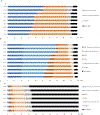Evaluation of Trends in Bronchopulmonary Dysplasia and Respiratory Support Practice for Very Low Birth Weight Infants: A Population-Based Cohort Study
- PMID: 34838581
- PMCID: PMC8960334
- DOI: 10.1016/j.jpeds.2021.11.049
Evaluation of Trends in Bronchopulmonary Dysplasia and Respiratory Support Practice for Very Low Birth Weight Infants: A Population-Based Cohort Study
Abstract
Objectives: To characterize the incidence of bronchopulmonary dysplasia (BPD) over time and to test the association of multilevel factors, including respiratory support, with the diagnosis of BPD.
Study design: This population-based cohort study included 40 268 infants born between 22 and 32 weeks of gestation at hospitals in California between 2008 and 2017. The diagnosis of BPD was based on respiratory support at 36 weeks postmenstrual age. Tests for linear trend and multivariable logistic regression analyses were performed.
Results: The rate of BPD was consistent year to year, and the mortality rate declined. The incidence of BPD was 23.5% for the overall cohort, 44.9% for infants born at <28 weeks of gestational age, and 45.2% for extremely low birth weight infants. For infants born at >26 weeks of gestational age, the incidence of BPD was significantly decreased in the most recent 3-year period compared with the earlier 3 years (OR, 0.91). Invasive ventilation during delivery room resuscitation (OR, 2.64) and after leaving the delivery room (OR, 10.02) conferred the highest risk of BPD compared with oxygen or no respiratory support. Noninvasive ventilation as maximum respiratory support at 36 weeks increased by 20% over time.
Conclusions: Marked changes in noninvasive support care have occurred without an overall decline in BPD rate. Further research, quality improvement, and strategies, along with noninvasive respiratory support, are needed for a reduction in the incidence of BPD.
Keywords: bronchopulmonary dysplasia; noninvasive ventilation; respiratory support; trends.
Copyright © 2021 Elsevier Inc. All rights reserved.
Figures
Comment in
-
Reduction in Mechanical Ventilation: Necessary but Not Sufficient to Prevent Bronchopulmonary Dysplasia in Infants Born Extremely Preterm?J Pediatr. 2022 Apr;243:12-13. doi: 10.1016/j.jpeds.2021.12.068. Epub 2021 Dec 30. J Pediatr. 2022. PMID: 34974061 No abstract available.
References
-
- Horbar JD, Edwards EM, Greenberg LT, Morrow KA, Soll RF, Buus-Frank ME, et al. Variation in performance of neonatal intensive care units in the United States. JAMA pediatrics. 2017;171:e164396. - PubMed
-
- Cheong JLY, Doyle LW. An update on pulmonary and neurodevelopmental outcomes of bronchopulmonary dysplasia. Semin Perinatol. 2018;42:478–84. - PubMed
Publication types
MeSH terms
Grants and funding
LinkOut - more resources
Full Text Sources




